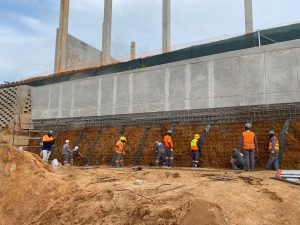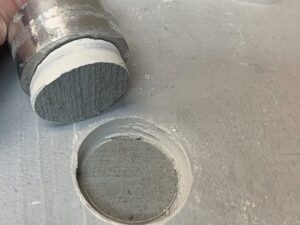Post-initial set applied colloidal silica significantly raises concrete durability.
Ultra-high durability levels are being imparted to conventional concrete mixes with a simple addition of these nano-sized materials. This is helping to construct more durable infrastructure and significantly prolong the service life of existing structural assets.
Colloidal silica (“nano silica”)
Post-initial set applied colloidal silica, “colloidal nano silica” or “nano silica” is a cutting-edge nano technology. It has been used for more than two decades throughout the world, including in South Africa. This is to make the oldest commodity-based material more durable and, therefore, longer lasting.
A case in point is municipal service-delivery infrastructure, such as wastewater-treatment plants and sewers. More recently, post-initial set applied colloidal silica is also being specified for manhole repairs. The technology is used to neutralise and remove contaminants from existing concrete before the manholes are repaired. When applied to the entire manhole area, corrosion potential can be substantially reduced. This, in turn, potentially increases the service life of the infrastructure by 20 years or more. A chemical-resistant coating is generally applied over treated concrete in wastewater-treatment plants, as well as sewers and manholes.
Colloidal silica provides permanent benefits
This single-spray application of post-initial set applied colloidal silica provides permanent benefits.
These amorphous silicon dioxide particles are less than 100 nano metres in size and suspended in water. They are spray-applied to horizontal, vertical or overhead concrete slabs after they have been cast.
Post-initial set applied colloidal silica’s small size provides a tremendous amount of reactivity and pozzolanic potential. It is even greater than that of un-densified silica fume. This reaction takes place in the capillary voids and pore space. These are created in concrete as bleed water exits the construction material. In this way, they are filled with more calcium-silicate hydrate (C-S-H). C-S-H is the same reaction product that provides concrete with its strength and durability traits. Even under hydrostatic pressure, the movement of water through concrete is restricted. This waterproofing action considerably reduces water-borne contaminant ingress, including the transport of chlorides, through concrete.
Chlorides damage the protective hydroxide layer on reinforcing bar. Also referred to as “passivation”, this layer is formed by the high alkalinity of concrete. Once it has been compromised, wet or dry cycles accelerate the continuous corrosion process. This is the lead cause of premature concrete failure.
By extending the period it takes for chlorides to reach reinforcing bar, years can be added to the lifecycle of concrete structures.
Colloidal silica’s tremendous ability
Three laboratories have corroborated post-initial set applied colloidal silica’s tremendous ability to significantly deaccelerate the rate of chloride through concrete. Using chloride diffusion testing, chloride concentrations at various depths were ascertained. These helped to calculate an average diffusion coefficient. This predicts the length of time it will take chlorides to reach reinforcing steel and penetrate the passive layer around it. The modelling was undertaken with sophisticated software, including Life 365 [http://www.life-365.org/overview.html]. It is a simple and transparent model. Many design consultants use it to estimate the service life and lifecycle costs of alternate protection systems. This is when designing reinforced concrete structures that are exposed to chlorides.
Post-initial set applied colloidal silica achieves a 69% reduction in chloride diffusion coefficient for concretes with W/C ratios of 0,57. Similar results are recorded for concretes with W/C ratios of 0,45. For concretes with a W/C ratio of 0,40, a 75% reduction in chloride diffusion coefficient is achieved.
Certainly, colloidal silica can also be applied as an admixture to concrete as it is being produced. However, many contractors still prefer to treat concrete slabs with colloidal silica after they have been cast. This allows the particles to penetrate the concrete deeply after the voids have been formed. Thereafter, it closes them in the interaction zone.
Notably, 99% of the world’s concrete is placed with excess water. This is because it is needed to achieve the initial chemical reaction, despite the use of effective chemical admixtures.
As this portion of water exits, it creates permanent bleed-water channels in the concrete. This increases the permeability of the construction material. Concrete permeability and durability are intrinsically linked. Concrete that is less permeable is going to be more durable. It will, therefore, last longer and fulfil its service life capabilities at a low maintenance cost.
Colloidal silica facilitates optimal curing
Post-initial set applied colloidal silica also facilitates optimal curing. This is over-and-above the role that it plays in raising concrete durability by waterproofing and densifying it.
Curing is an essential component of quality assurance and control during construction. Curing ensures high-strength gain; minimising thermal, plastic and drying-shrinkage cracks. This makes concrete more water-tight; and improves abrasion resistance. Moreover, proper curing advances the microstructure of concrete by assisting the cement-hydration reaction to progress steadily. The calcium-silicate hydrate gel that is created during this process binds aggregates to form a rock-solid mass. This makes concrete denser; decreases porosity; and enhances its physical and mechanical properties.
Post-initial set applied colloidal silica retains water that would normally evaporate to ensure continued hydration. This is demonstrated by improved compressive strength and significant drying shrinkage reduction of concrete treated with the technology. Post-initial set applied colloidal silica-treated concrete even outperforms moist-cured concrete. Moist curing is considered the “gold standard” of curing practices.
Many benefits of colloidal silica
The many benefits of post-initial set applied colloidal silica are still being researched.
Over 100 research papers authored by over 15 research teams have demonstrated the improved properties of concrete containing colloidal silica. It has either been applied as an admixture during mixing or after slabs have been cast. Moreover, two ASTM [https://www.astm.org/] working groups have been assigned to just work on colloidal silica specifications.
Notably, a representative of United States-based SprayLock Concrete Protection (SCP) [https://www.concreteprotection.com/] serves on one of these working groups. SCP is the foremost manufacturer and supplier of post-initial set applied colloidal silica, which conforms to the EN1504-2 durability standard. Refer to BS EN 1504-2:2004 Products and systems for the protection and repair of concrete structures. Definitions, requirements, quality control and evaluation of conformity Surface protection systems for concrete (en-standard.eu).
The company’s spray-applied products have earned a solid reputation the world over for their ability to protect concrete from contaminants.
Cutting-edge of colloidal silica
The United States has been at the cutting-edge of post-initial set applied colloidal silica research. This includes the significant efforts made by the US Army Corps in the field since the early 2000s. These efforts, in particular, stimulated worldwide interest in the technology.
Even in a highly developed country such as the United States, concrete structures have not been performing as they should. The leading cause of the premature failure of concrete structures in the country is due to alkali–silica reaction. This can be attributed to higher alkali cements; more reactive aggregates; and ineffective pozzolans.
About USD48-billion is invested in new concrete structures in the United States every year. Yet, USD8,3-billion is spent annually maintaining them as a result of physical and chemical attack.
One in six of the more than 600 000 concrete bridges in the country are in severe need of replacement or repair. This is according to the American Society of Civil Engineers’ Infrastructure Report Card of 2012. Refer to https://www.asce.org/.
Meanwhile, the mix designs for 40% of the country’s concrete bridges have a life expectancy of less than 30 years. This is according to a study undertaken by the American Society of Military Engineers [Home – SAME] in 2015.
At the same time, building repair costs in the United States are expected to be about USD20-billion a year. Most structures are only expected to last between 50 to 60 years. This is according to the International Concrete Research Institute [https://www.icri.org/].
In areas of the country where de-icing salts are used on sidewalks and pavements, this infrastructure only lasts for five years. Where the salt melts, snow build-up creates saltwater slush that enters concrete. Once inside the concrete, it refreezes. This additional pressure starts breaking up concrete. In addition, salt water, itself, contains magnesium chloride, as well as sulphate and hydrogen carbonation ions. This corrodes the concrete and rebar.
SCP’s unique colloidal silica P3
SCP’s post-initial set applied colloidal silica technology has been very effective in safeguarding new and existing concrete from salt-water attack. This includes bridges, dams, piers and other structures that are located within 0,8km or more of a body of water. The company’s top-of-shelf formulation improves concrete durability of structures exposed to harsh marine conditions by 90% or more. This is according to the EN 12390-8 testing standard. BS EN 12390-8:2019 Testing hardened concrete Depth of penetration of water under pressure (en-standard.eu).
SCP also improves chloride diffusion by 50% and reduces forced chloride ingress by 25% or greater. This is according to the ASTM C1556 and NT Build 492 testing standards, respectively. Refer to C1556 Standard Test Method for Determining the Apparent Chloride Diffusion Coefficient of Cementitious Mixtures by Bulk Diffusion (astm.org). Reference https://ebaengineering.com/nt-build-492-an-option-for-concrete-durability-testing-youve-never-heard-of/.
South Africa is also grappling with a growing infrastructure backlog. This while existing service delivery assets are deteriorating because of insufficient maintenance. Therefore, the focus is increasingly on extending the life of existing infrastructure. Meanwhile, new infrastructure must be designed in such a way that it continues adding value over its entire lifecycle. This while reducing maintenance costs. SCP products help designers to achieve these objectives.






